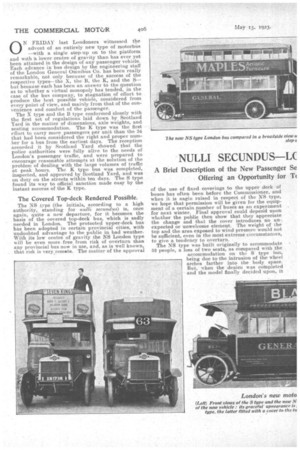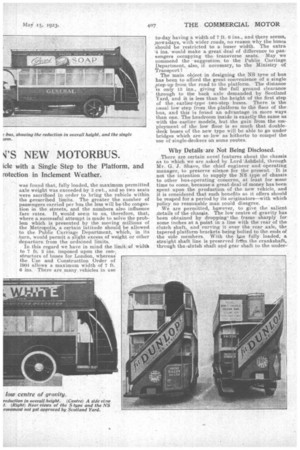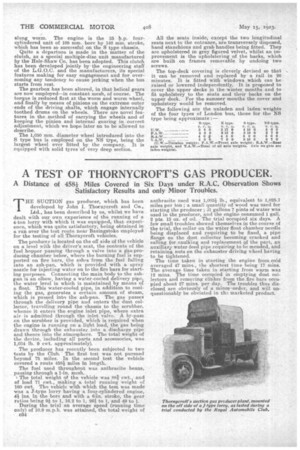NULLI SECUNDUS L( g'S NEW MOTORBUS.
Page 18

Page 19

Page 20

If you've noticed an error in this article please click here to report it so we can fix it.
A Brief Description of the New Passenger Se Offering an Opportunity for T( icle with a Single Step to the Platform, and rotection in Inclement Weather.
ON FRIDAY last Londoners witnessed the advent of an entirely new type of motorbus —with a single step-up on to the platform and with A lower centre of gravity than has ever yet been attained in the design of any passenger vehicle. Each advance in bus design by the engineering staff of the London General Omnibus Co. has been really remarkable, not only because of the success of the respective types—the X, the B, the K, and the 5— but because each has been an answer to the question as to whether a virtual monopoly has tended, in the case of the bus company, to stagnation of effort to produce the best possible vehicle, considered from every point of view, and mainly, from that of the convenience and comfort of the passenger.
The X type and the B type conformed closely with the first set of regulations laid down by Scotland Yard in the matter of dimensions, axle weights, and seating accommodation. The K type was the first effort to carry more passengers per unit than the 34 that had been considered the right and proper number for a bus from the earliest days. The reception accorded it by Scotland Yard showed that the police authorities were fully alive to the needs of London's passenger traffic, and were prepared to encourage reasonable attempts at the solution of the problem of dealing with the large volumes of traffic at peak hours. The K type bus was completed, inspected, and approved by Scotland Yard, and was on duty on the streets within ten days. The S type found its way to official sanction made easy by the instant success of the K type.
The Covered Top-deck Rendered Possible.
The NS type (the initials, according to a high authority, standing for nulli secundus) is, once again, quite a new departure, for it becomes the basis of the covered top-deck bus, which is sadly needed in London. The protected upper-deck bus has been adopted in certain provincial cities, with undoubted advantage to the public in bad weather. With its low centre of gravity the NS London type will be even more free from risk of overturn than any provincial bus now in use, and, as is well known, that risk is very ,remote. The matter of the approval
of the use of fixed coverings to the upper deck of buses has often been before the Commissioner, and when it is aagin raised in respect of the IS type, we hope that permission will be given for the equipment of a certain number of buses as an experiment for next winter. Final approval could depend upon whether the public then show that they appreciate the change and that the cover introduces no unexpected or unwelcome element. The weight of the top and the area exposed to wind pressure would not be sufficient, even in the most extreme circumstances, to give a tendency to overturn.
The NS type was built originally to accommodate 52 people, a loss of two seats, as compared with the accommodation on the S type bus, being due to the intrusion of the wheel arches farther into the body space. But, when the design was cotapleted and the model finally decided upon, it
was found that., fully loaded, the maximum permitted axle weight was exceeded by 3 cwt. and so two seats were sacrificed in order to bring cwt., vehicle within the prescribed limits. The greater the number of passengers carried per bus the less will be,the congestion in the streets, and the numbers also influence fare rates. It would seem to us, therefore, that, where a successful attempt is made to solve the problem which is presented by the moving millions of the Metropolis, a certain latitude should be allowed to the Public Carriage Department, which, in its turn, would permit a slight excess of weight or other departure from the ordained limits.
In this regard we have in mind the limit,.of width to 7 ft. 2 ins, imposed upon the con-. structors of buses for London, whereas' the Use and Construction Order of 1904 allows a maximum width of 7 ft. 6 ins. There are many vehicles in use
to-day having a width of 7 ft. 6 ins., and there seems, nowadays, with wider roads, no reason why the buses tihould be restricted to a lesser width. The extra '4 ins, would make a great deal of difference to passengers occupying the transverse seats. May we commend the suggestion to the Public Carriage Department, .also, if necessary, to the Ministry of Transport? The main object in designing the NS tyne of bus has been to afford the great convenience of a single otep-up from the road to the platform. The distance is only 13 ins., giving the full ground clearance through to the back axle demanded by Scotland Yard, and it is. less than the height of the first step of the earlier-type two-step buses. There is the usual low step from the platform to the flow of the bus, and this is found an advantage in more ways than one. The headroom inside is exactly the same as with the earlier models, but the gain from the ernployment of the low floor is so much that doubledeck buses of the new type will be able to go under bridges which are so low as hitherto to compel the use of single-deckers on some routes.
Why Details are Not Being Disclosed.
,There are certain novel features about the chassis as to which we are asked by Lord 'Ashfield, through Mr. G. J. Shave, the chief engineer and operating manager, to preserve silence for the present. It is not the intention to supply the NS type of chassis to other bus-operating concerns, at least for some time to come, because a great deal of money has been spent upon the production of the new vehicle, and it is considered that such benefits as it offers should be reaped for a period by its originators--with which policy no reasonable man eould disagree.
' We are permitted, however, to give the salient .details of the chasais. The low centre of gravity has been obtained by dropping' the frame sharply for some inches at a point m a line with the rear of the clutch shaft, and curving it over the rear axle, the tapered platform bracketsbeing bolted to the ends of the side members. With the has fully loaded, a straight shaft line is preserved fetrrn the crankshaft, through the ,clutch shaft and gear shaft to the under
slung worm. The engine is the 35 b.p. fourcytindered unit of 108 mm. bore by 140 mm. stroke, which has been so successful an the S type chassis. Quite a departure is made in the matter of the clutch, as a special multiple-disc unit manufactured by the Hele-Shaw Co. has been adopted. This clutch has been developed jointly by the engineering staff of the L.G.O.C. and the manufacturers, its special features making for easy engagement and for overcoming any tendency to cause jerking when the bus starts from rest.
The gearbox has been altered, in that helical gears are now employed—in constant mesh, of course. The torque is reduced first at the worm and worm wheel, and finally by means of pinions on the extreme outer • ends of the driving shafts, which engage internally toothed drums on the wheels. There are novel features in the method of carrying the wheels and of keeping the pinion and internal gearing in correct adjustment, which we hope later on to be allowed to describe.
The 1,050 mm. diameter wheel introduced into the S type bus is employed on the NS type, being the largest wheel ever fitted by the company. It is equipped with solid tyres of very deep section. All the seats inside, except the two longitudinal seats next to the entrance, are transversely disposed, hand stanchions and grab handles being fitted. They are upholstered in grey figured velvet, whilst an improvement is the upholstering of the backs, which are built on frames removable by undoing two screws.
The top-deck covering is cleverly devised so that it can be removed andreplaced by a rail in 20 minutes. It is fitted with windows which can be raised or lowered independently.. It is proposed to cover the upper decks in the winter months and to fit upholstery to the seats and their backs on the upper deck. For the summer months the cover and upholstery would be removed.
The following are the unladen and laden weights of the four types of London bus, those for the NS type being approximate :—
B type. K type. S type b:18 type.
T. C. Q. T. C. Q. T. C. Q. T. C. Q.
U W 3 8 0Si? 0 4W 0 5 0 0 F.A.W. 2 0 0 2 15 0 3 10 0 3 7 0 RA.W. 40 4 6 0 5 0 0 5 0 0
6 0 01 7 0 0 8 10 0 8 0 (U. W.—Unladen weight ; F.A.W.—Front xxle weight ; FLAW.—Rear axle weight, and T.A.W.--Total of all axle weights. Axle we ghte are laden weighte).






























